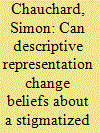| Srl | Item |
| 1 |
ID:
133030


|
|
|
|
|
| Publication |
2014.
|
| Summary/Abstract |
Can descriptive representation for a stigmatized group change the beliefs and intentions of members of dominant groups? To address this question, I focus on quotas (reservations) that allow members of the scheduled castes to access key executive positions in India's village institutions. To measure the psychological effect of reservations, I combine a natural experiment with an innovative MP3-player-based self-administered survey that measures various beliefs and behavioral intentions. Results provide credible causal evidence that reservations affect the psychology of members of dominant castes. Even though villagers living in reserved villages continue to think poorly of members of the scheduled castes (stereotypes do not improve), reservation affects two other types of beliefs: perceived social norms of interactions and perceived legal norms of interactions. These changes in beliefs in turn appear to have far-reaching consequences for intercaste relations, as villagers' discriminatory intentions also decrease under reservation.
|
|
|
|
|
|
|
|
|
|
|
|
|
|
|
|
| 2 |
ID:
186045


|
|
|
|
|
| Summary/Abstract |
The idea of “dominant caste” has been important in the discourse of caste that saw the movement from social intercourse (hierarchy, purity-pollution) to political mediation (representation, demand for positive discrimination) in various literature. This paper offers a longitudinal study of caste relations in and around Varanasi in North India, focusing on the Brahmin caste vis-à-vis another dominant caste (non-Brahmin). It combines historical material with individual-level data set, the findings of which are presented as a case study. The essay’s objectives are as follows (a) description and analysis of two different “dominant” castes to understand the functioning of the caste identity in contemporary India. This is done to reevaluate how the castes have sought to convert their historically accrued caste capital into social or political capital; (b) the relationship between the two “dominant” castes. It was found that dominance was regionally located in both cases, but in the colonial period, it depended on caste hierarchy, unlike in post-colonial/modern days. This recreated a sort of discrimination manipulated by the dominant castes at their respective levels.
|
|
|
|
|
|
|
|
|
|
|
|
|
|
|
|